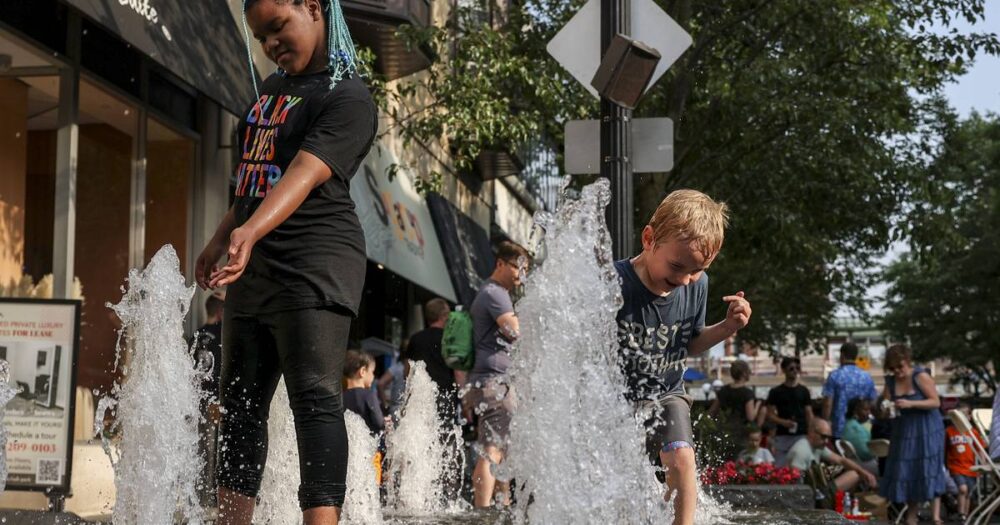On a recent Thursday evening, the streets of Oak Park were crowded with people, camping out in lawn chairs as they listened to live music, popping in and out of storefronts and watching their kids run around.
The street was lined with food, drink and art vendors for “Thursday Night Out,” a weekly event during the summer months to bring people in the Chicago suburb together downtown.
Families navigated stroller traffic jams on the sidewalks as groups of teens decided what activity to do next. In the theme of June’s Pride Month, drag queens strolled up and down the street, stopping to take photos with attendees.
Dwayne Smith, 53, attended with his daughter Rachel. A former real estate professional, Smith said Oak Park is one of the most diverse communities in the Chicago area, especially his neighborhood on the village’s southern end. Rachel, 10, said she likes how random people on the street say hello to you.
But it’s not perfect, her father said.
“I believe there are still a lot of siloed groups as it comes to race,” Smith said. “Many of the neighborhoods are integrated, but certain people gravitate toward certain parts of the city.”
Over the last 50 years, Oak Park has succeeded in transforming itself from a majority-white enclave to a more racially diverse community through a series of policy measures aimed at promoting integration. But new pressures from a lack of affordable housing to sky-high property taxes and lingering racial tensions threaten to undo those gains, some community members and stakeholders say.
“As it stands, we are one of the most integrated communities in the nation,” Village Board President Vicki Scaman said at a recent meeting of the Oak Park board of trustees. “But we could lose that integration if we become less and less affordable.”
Cynthia Riccolo, 58, moved to Oak Park from Chicago about 20 years ago in search of a diverse community close to the city. She said she can’t imagine living anywhere else, even though “the (property) taxes are ridiculous.”
She stays because she likes the people.
“I love it,” Riccolo said, pausing to take a photograph with drag queens at her art booth at the recent Thursday event. “I didn’t want my daughter raised in an environment that wasn’t accepting.”
Smith, who has lived in Oak Park about seven years, said he saw the property tax bill for his roughly $425,000 house go up about 10% in his recent assessment.
“Taxes aren’t cheap here, so for some that is a huge hit,” he said.
Homes in Oak Park Township were reassessed this year, with many homeowners experiencing sticker shock. Measures intended to flatten the pandemic’s economic shock for property owners have worn off, and home values now reflect the rocketing prices that started in 2020.
The median monthly sale price for homes in Oak Park has crept up in recent years, ranging between $193,000 and $365,000 in 2019 to between $272,500 and $440,000 in 2022, according to Zillow. Current sale prices are 4% higher than a year ago, according to the data. Meanwhile, the typical rent in Oak Park has gone from $1,609 right before the pandemic to $1,867 in June, according to Zillow.
Like many communities in the Chicago area, Oak Park’s housing stock is suffering from a “missing middle,” said officials with the Oak Park Regional Housing Center, a nonprofit that promotes diversity and integration in the rental market. People with incomes ranging from $50,000 to $80,000 often make too much money to qualify for subsidized housing but not enough to afford market-rate housing or to buy a home, housing center officials said.
The village has hired a firm to conduct a study assessing its housing needs, which will help officials determine how to move forward with integration efforts, Oak Park Village Manager Kevin Jackson said. The assessment likely won’t be finalized until the end of the year.
“We have a historical foundation with the housing center, but these assessments will help us look at the partnership to see what it will look like in the future,” Jackson said.
Founded in 1972, the housing center connects renters with landlords through a practice called “affirmative moves.” It shows renters housing options that would promote or sustain integration based on U.S. census data, while offering them a more complete list of available rentals if they choose.
The housing center said it has helped move about 6,200 renter households to Oak Park over the past 10 years, an estimated one-third of all the renter moves to the area over that time period. Of those moves, about 67% made an affirmative move.
Integration data from a project through the University of California at Berkeley’s Othering & Belonging Institute shows low levels of segregation in Oak Park, unlike Chicago and Cook County as a whole. The project finds that Chicago is the second most segregated metro area behind New York City. This is significant because, the study said, segregation causes poor outcomes related to public health, education and economics for communities of color compared with white communities, whereas integrated neighborhoods provide more resources and better life outcomes.
Scaman, the board president, said some of the challenges with integration over the past few years have stemmed from a tense relationship between the Village Board and the housing center. Some former board members questioned how active the community needed to be to maintain integration, and the housing center experienced staff turnover.
Athena Williams, executive director of the housing center, said recent budget cuts from the village have hurt the center’s ability to do its work. She said thousands of people register for the “Live in Oak Park” integration program each year, but the center is only able to help around 450 people.
“I also worry about if we don’t continue the work, will Oak Park become just another suburb like most other suburbs where it’s not integrated, where diversity is not there?” Williams said.
The village’s budget shows the housing center received $425,000 in fiscal year 2018, before funding dropped to $300,000 between 2020 and 2022, then rose again to $352,500 for 2023.
The housing center also receives funding from the U.S. Department of Housing and Urban Development through the village. This funding has also waned in recent years.
Baxter Swilley, who does policy and government relations work for the housing center, said the housing center is “re-imagining what our work looks like” but is not ready to discuss the specifics until after the center submits its budget request to the village in the next few weeks.
Scaman said the housing study will be an opportunity for the village government to come together with the housing center to create a plan for the years to come after this next budget season.
“Are affirmative moves still the response for the future or not?” Scaman said. “And if not, then what is?”
Oak Park began taking steps to integrate in the 1960s with the passage of a Fair Housing Ordinance.
When the housing center began its work, Oak Park was still overwhelmingly white, said Rob Breymaier, the center’s director from 2006 to 2018.
Now, that number is around 60.5%, with Black residents making up around 18.5% of the population, Latino residents around 10%, Asian residents around 5.5% and a mixed-race population of around 8.5%, according to census data. Those numbers more closely mirror the racial demographics of Cook County than the majority of the rest of the neighborhoods in the county.
Over the last decade or so, the village of about 52,000 has seen its Black and white populations decline while the percentage of Latino and mixed-race residents has grown.
Breymaier attributes the decline in the Black population to two main factors: First, marketing efforts changed from promoting Oak Park as a diverse and inclusive community to “the next hot neighborhood” given the development boom in the downtown area.
Second, the community began having more open discussions following the 2018 docuseries “America To Me,” chronicling the lives of 12 students at Oak Park River Forest High School and highlighting issues related to race and class.
“It didn’t put us in the greatest light,” Breymaier said, which he thinks led to Black families avoiding Oak Park.
“We’ve been very vocal that the community needs to refocus itself in its marketing and branding as an open and inclusive place … and hold ourselves up to those principles,” Breymaier said. “I think that’s part of what has to happen in order for us to regain the level of success we used to have.”
Parents of Black students at Oak Park and River Forest High School told the Tribune their students have received disparate treatment from faculty and staff compared with white students.
Melanie McQueen, president of the African American Parents for Purposeful Leadership in Education in Oak Park since 2013, said Black students are punished more than white students, often being marked late and/or receiving detention.
About 57% of disciplinary infractions reported in the 2021-2022 school year at the high school were against Black students compared with about 22% against white students, according to school data. Black students make up about 18% of the student body, whereas white students make up about 56%.
McQueen said not much has changed over the years, with the pandemic causing more mental health issues for students.
“Our kids are still not getting the fair treatment they deserve,” said McQueen, who is a mortgage loan officer and mother to two current high schoolers and one graduate.
“There are not enough preventive measures in place, and there’s still not enough relationships being built to assist our kids,” she said.
Greg Johnson, Oak Park River Forest High School’s superintendent, and Lynda Parker, assistant superintendent and principal for the school, said since they have been in the district — seven and six years, respectively — many programs and policies have been put in place to be equitable and race conscious.
The school passed a racial equity policy, changed freshman year curriculum and amended its approaches to punishment to be less exclusionary and more restorative and educational, Johnson and Parker said.
“We work daily trying to combat that by keeping it on the forefront of not only our minds but in our conversations and our actions so that we are not shying away from the challenges that are presented,” Parker said. “This is going to be constant work because of how we started as a country.”
In recent meetings, Village Board members have talked in depth about their goals for the next two years, focusing on diversity, inclusion, integration and housing affordability.
Board members threw out ideas such as a mortgage assistance program and a village-run housing voucher program as ways to mitigate affordability issues. They also highlighted the need for Oak Park to become more inclusive of cultural diversity to help retain families and businesses.
Housing center officials have expressed similar sentiments. Next spring, the center will launch a program called “Power in Engagement” with other area organizations focused on housing stability for people of color in Oak Park, said Williams, the center’s executive director.
The housing center also sees potential to replicate its work in Oak Park in other communities, including Chicago’s Austin neighborhood, which borders the village’s east side.
The housing center has provided grants to 2-4-unit building owners to maintain their housing stock and offered classes to help people become homeowners and boost economic integration. “If they want (integration), we are here for it,” Williams said.
Swilley, of the housing center, said communities have the tools to navigate integration challenges such as zoning restrictions and inflation. He said Oak Park has confronted these challenges and serves as an oasis where people can come to see what is possible.
“It is important that a place like this exists in America,” Swilley said. “It is important that we know how much it costs and know how long it takes. … We can do this, and we can do this everywhere with a little bit of elbow grease.”







